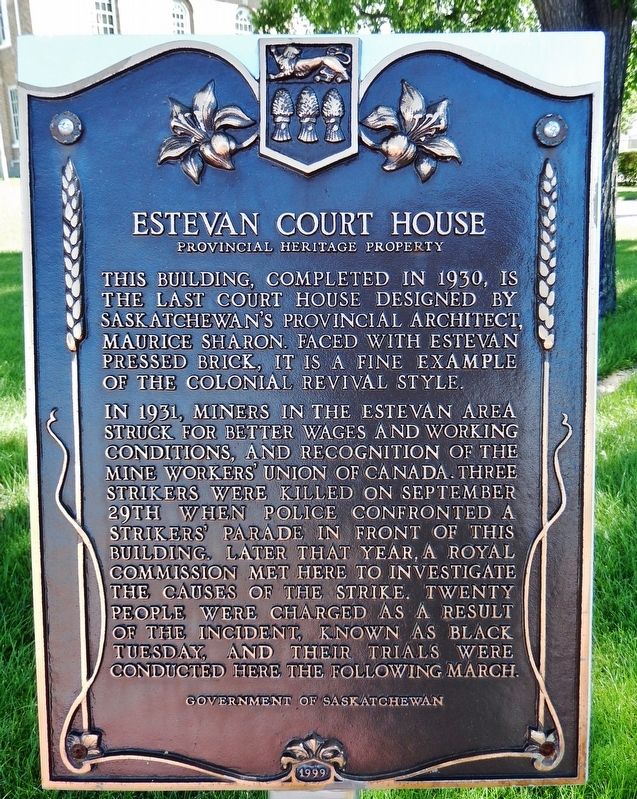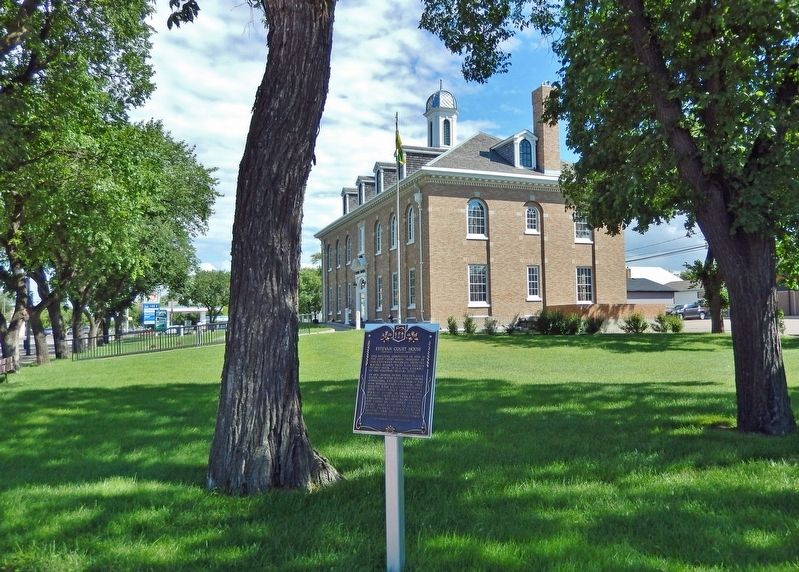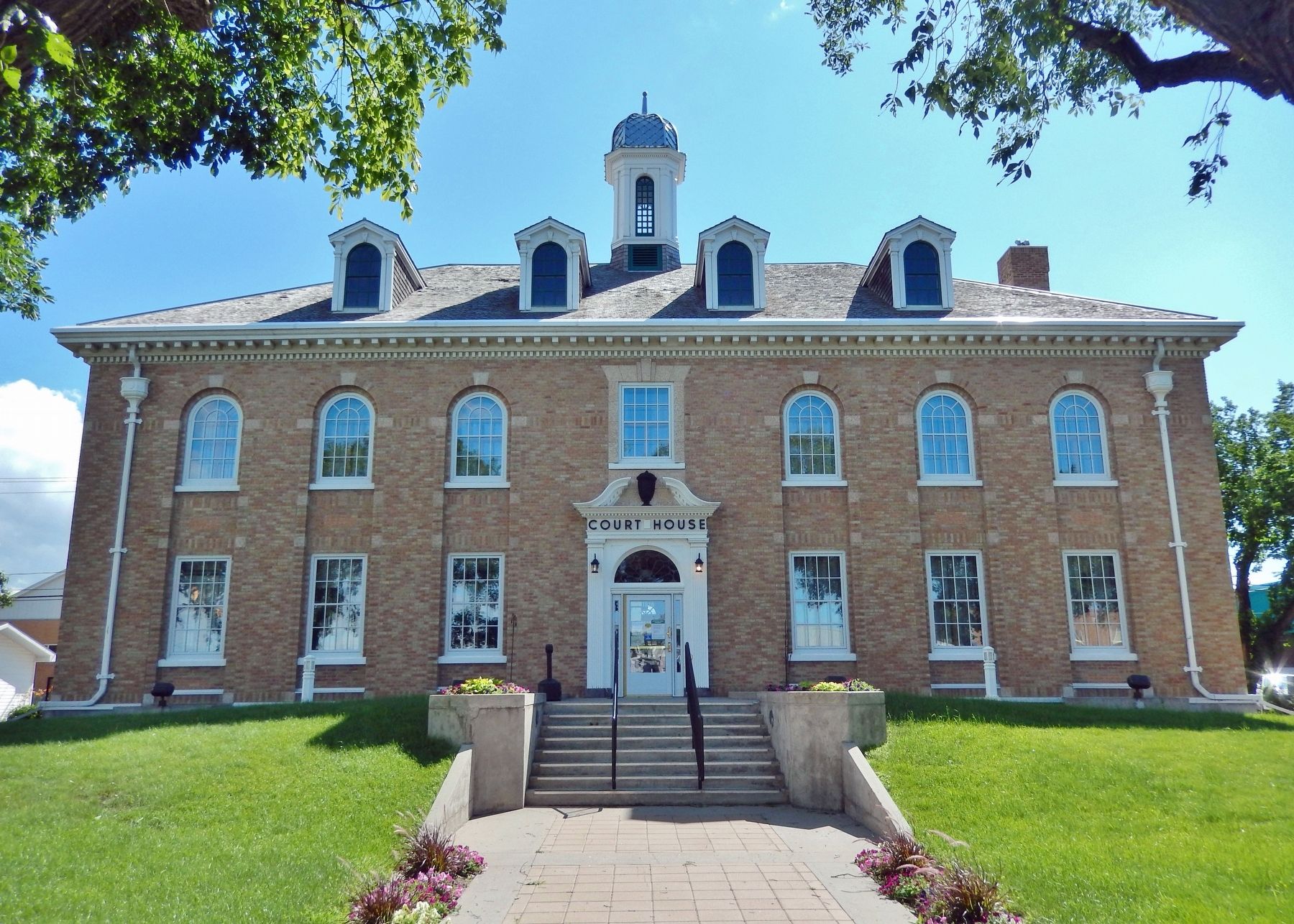Estevan in Estevan No. 5, Saskatchewan — The Prairie Region (North America)
Estevan Court House
Provincial Heritage Property
This building, completed in 1930, is the last court house designed by Saskatchewan’s Provincial Architect, Maurice Sharon. Faced with Estevan pressed brick, it is a fine example of the Colonial Revival style.
In 1931, miners in the Estevan area struck for better wages and working conditions, and recognition of the Mine Workers’ Union of Canada. Three strikers were killed on September 29th when police confronted a strikers’ parade in front of this building. Later that year, a royal commission met here to investigate the causes of the strike. Twenty people were charged as a result of the incident, known as Black Tuesday, and their trials were conducted here the following March.
Erected 1999 by Government of Saskatchewan.
Topics. This historical marker is listed in these topic lists: Architecture • Industry & Commerce • Labor Unions • Law Enforcement. A significant historical year for this entry is 1930.
Location. 49° 8.363′ N, 102° 59.566′ W. Marker is in Estevan, Saskatchewan, in Estevan No. 5. Marker is on 4 Street (Provincial Highway 18/47) just east of 11 Avenue, on the right when traveling east. Marker is located near the northwest corner of the Estevan Court House grounds. Touch for map. Marker is at or near this postal address: 1016 4 Street, Estevan SK S4A 0W5, Canada. Touch for directions.
Other nearby markers. At least 1 other marker is within walking distance of this marker. "Coal Miners' Corner" (about 90 meters away, measured in a direct line).
Regarding Estevan Court House. Canadian Register of Historic Places (2005); and Saskatchewan Provincial Heritage Property (1988).
Related markers. Click here for a list of markers that are related to this marker. Estevan Court House
Also see . . .
1. Estevan Court House.
The building is one in a series of court houses designed by the office of the provincial architect, a government department responsible for the design and/or supervision of all public buildings from 1905 until the office was discontinued in the early 1930's amidst the Depression. The Estevan Court House is the last building to be designed by Sharon during his tenure as Provincial Architect, and represents a mature development of his use of the Colonial Revival style for public buildings. Clad entirely in medium-brown Estevan pressed brick, with small amounts of Tyndall Stone trim, the maturity of the style is witnessed in the fluted pilasters and a curved broken pediment which frame the doorway and the double-height window recesses toppedby arches on the second storey. (Submitted on August 14, 2022, by Cosmos Mariner of Cape Canaveral, Florida.)
2. Saskatchewan coal miners win strike for better working conditions, 1931.On September 29, 1931, the miners and their families, along with union representatives, held a peaceful parade that started in Bienfait and ended in Estevan, Saskatchewan. The miners had hoped that the parade would make their struggles public and would help them gain more local support. As the motorcade got closer to the center of Estevan it was stopped by over two-dozen police officers. The miners were ordered to end the parade and disperse, but when the miners refused, one police officer tried to pull a striker from his truck. The police called for a fire truck to come and hose down the crowd, in an attempt to break-up the strikers, even though there were women and children in the crowd. A small group of strikers began climbing on a fire truck that had been called in by the police. As the men stood on top of the fire truck the police began shooting, and one man standing on the truck was killed. During the police gunfire, two other male strikers were also killed. By the end of the struggle, the police gunfire had also wounded eight unarmed strikers, four bystanders, and one member of the Royal Canadian Mounted Police.(Submitted on August 14, 2022, by Cosmos Mariner of Cape Canaveral, Florida.)
3. Maurice Willliam Sharon (1875-1940). Biographical Dictionary of Architects in Canada 1800-1950:
Sharon made a major contribution to the architecture of Saskatchewan, designing fifteen courthouse buildings, as well as telephone exchange buildings, police headquarters buildings, hospitals and sanatoria, and several provincial Normal School buildings. With steeply pitched roofs and meticulous detailing in a Georgian Revival style, his courthouse designs often draw upon the domestic tradition which seems rooted in the American Federal style, still visible today at historic sites such as Williamsburg, Va. No other Canadian architect has matched the quality and consistency of his designs for provincial court buildings from this period of 1915 to 1930, and his elevational treatment of each has a dignity and presence rarely attained by other provincial chief architects who were active at this time.(Submitted on August 14, 2022, by Cosmos Mariner of Cape Canaveral, Florida.)
Credits. This page was last revised on October 7, 2022. It was originally submitted on August 14, 2022, by Cosmos Mariner of Cape Canaveral, Florida. This page has been viewed 100 times since then and 10 times this year. Photos: 1, 2, 3. submitted on August 14, 2022, by Cosmos Mariner of Cape Canaveral, Florida.


